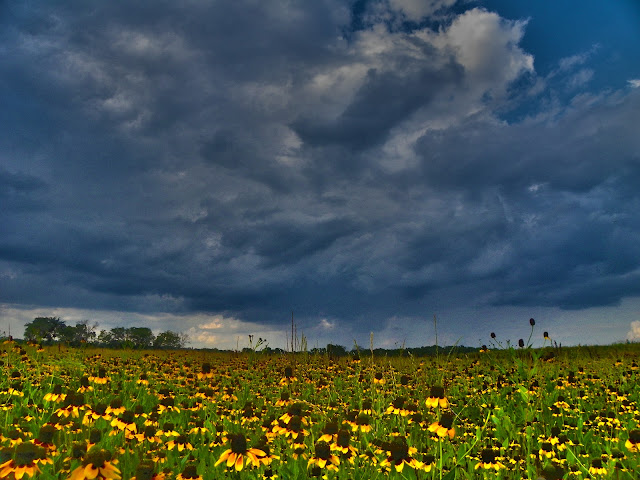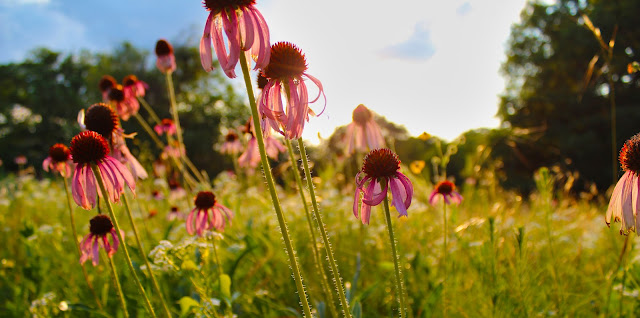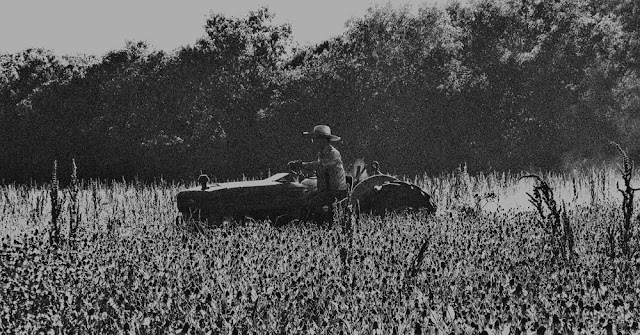Storm Over The Trinity River Wetlands
A brief storm popped up over East Dallas on the evening of May 13, 2012 and meandered south over the Great Trinity Forest. Most of the bottomland down there is flat, save for a pyramid sized mound of dirt at the Wetland Cells that rises above the floodplain some 30 feet. Using that as a vantage point I watched the virga turn to an early evening rain.
I would imagine that in some point in the future, a master plan for the area calls for a pavillion of some kind to be built on top of the pyramid. It offers a unique vantage point of downtown to the north and the unobstructed view of the crescent shaped wetland chain from I-45 to Loop 12. This spring wildflowers covered the acre sized top to it.
 |
| Horsemint on the acre sized top of the wetland “pyramid” |
Random Wildflowers From Around The Base of The Pyramid
I had a hunch that waiting around for the shower to blow over would yield a rainbow and sure enough one briefly appeared. The pot-o-gold location would probably have been near the Audubon Center.
 |
| Rainbow over the Trinity River May 13, 2012 |
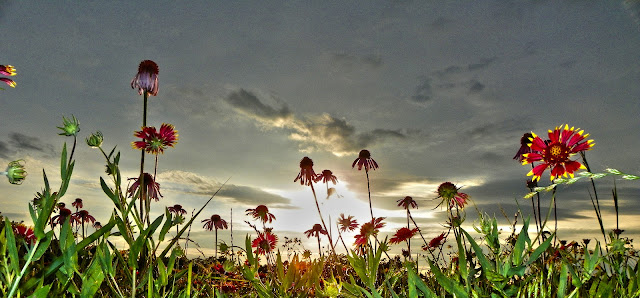 |
| Dripping wet wildflowers after an evening spring shower |
Prohibition, The Dean Law and G.G. Kirby the Moonshiner
 |
| Wallace Jenkins and County Agent A.B. Jolley May 11, 1952 |
The history of the area known as the Wetland Cells and Horse Park on opposing banks of the river is a jigsaw puzzle full of pieces. Like an old puzzle left in an attic with pieces missing. Hard to get a good picture of why things are they way they are. You find a piece here and there, find out where they belong and a picture starts to emerge. Much of the history that happened along the Trinity is long since forgotten. Lost two or three generations ago when many of the original farms were sold for residential housing or commercial use. Some of the back story behind this forgotten past is amazing. Mr Billy Ray Pemberton might be one of the few that still knows about it.
A number of people when visiting a real old place with a ton of history wonder what it looked like decades or even half a century ago. How it “used to look” before. Or back in the “good old days”.
Well…the two black and white photos above might give some insight into that.
The top photo was featured in the May 11, 1952 edition of the Dallas Morning News. The article is about Wallace Jenkins(seen on the left) and County Agent A.B. Jolley on Jenkins farm. Jenkins bought the 1700 acre property at depression era prices in 1938 for $27 an acre. Known as the Kirby Farm, it once sat on both sides of the Trinity River from Rochester Park(William Blair Park) down to Loop 12. That sixty year old article has Jenkins and Jolley standing in a chest high field of oats that would yield 100 bushels an acre. Mr Pemberton as a kid recalls seeing Wallace Jenkins driving around surveying his farm and pecan groves from his cars, 1941 and 1942 model Lincoln Zephyrs. Mr Pemberton even worked as a yard boy at their home for a time.
The second black and white photo was taken just about in that same spot. Same patchwork collection of fields that stretch from 175 to Loop 12. The difference is that the second black and white photo is not from 1952 but literally sixty years later, to the day, the evening of May 9, 2012…….
 |
| Billy Ray Pemberton May 9, 2012 |
Same spot. Same field for the most part.
Mr Pemberton is proud of that tractor. I met him that evening in that lower pasture where he was brush hogging and collecting old tires. He stopped at the edge of the field there after I took the photo above. He was telling me how he had driven that tractor(trailered) across the new Margaret Hunt Hill Bridge a couple weeks before to a mowing job in West Dallas.
Wallace Jenkins acquired the old Kirby Farm(now the future site of the Texas Horse Park) at a time when it was in disrepair. The previous owner, G.G. Kirby was a man that seemed to lack a moral compass and engaged in all matters of nonsense in the 1910s-1930s. He was one of the few Dallas County residents who was prosecuted to the fullest extent of the federal Prohibition laws and the Dean Act of 1919. Texas has some screwy liquor laws stemming back to 1854. When the 18th Amendment was ratified by Texas in March 1918, a new campaign began to add teeth to the toothless tiger of the amendment. So the Dean Act was passed in 1919 which made alcohol production, sales and consumption a felony in Texas punishable by up to 5 years in prison.
In the cross hairs of this was G. G. Kirby. Where there is a will, there is a way and I guess Kirby fancied the booze so much that he built the largest moonshine still ever, in Dallas County. He became what was known back then as a “wet farmer”. Right down there near the Horse Park. According to the old newspaper articles, it was the finest drinking moonshine anyone had ever tasted. No mention of how he ran his still or what he used as a mash. Loose lips sink ships and within a year he found himself in court arraigned on a dozen charges of illegal liquor production, sales and consumption. He and his co-conspirators had no chance at their trials. Every minister in town lined up to testify against the moral depravity Kirby brought to their flocks.
Kirby was a cooked goose it seemed. That was until Texas elected its first female Governor, Ma Ferguson in 1924. One of here platforms was to pardon the couple hundred convicted “wet farmers”. One of which being G.G. Kirby. He found himself off the hook and never to have his name printed again. Some years later, Wallace Jenkins bought the old Kirby Farm, one that no one thought could be worth anything.
Jenkins turned the Kirby farm into one of the most productive farms ever in Dallas County. He was successful in keeping his farm intact during the site selection for the sewage treatment plant and the larger landfill site that later became McCommas Bluff. He argued that the 25 feet of blackland clay under his farm would be wasted if turned into a sewage plant. It’s interesting to see the twists and turns of how some drunk moonshiner’s misfortune with the law probably kept Rochester Park and Joppa from becoming a dump and a waste water plant.
Maybe that’s where the city sits today with the Great Trinity Forest. If you replace an old moonshiner like Kirby with a modern day meth lab or pot field…you get the idea that the socioeconomic and political hurdles facing that area are not new ones. They are as old as the land itself. Only the faces and names change.
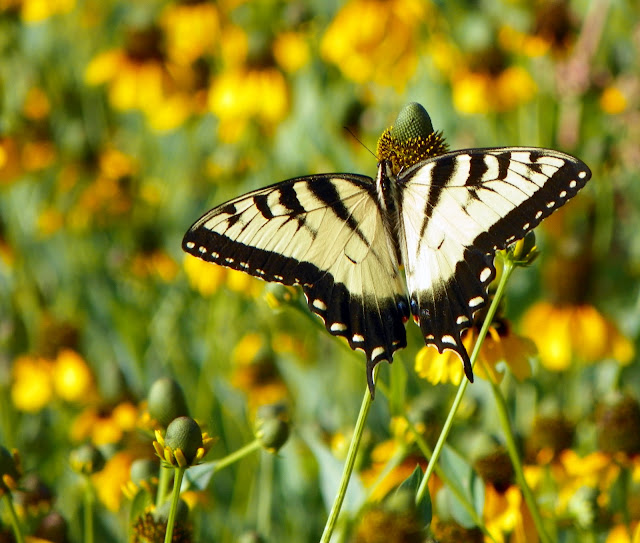 |
| Swallowtail Butterfly among the wildflowers of the Pemberton Meadow |
